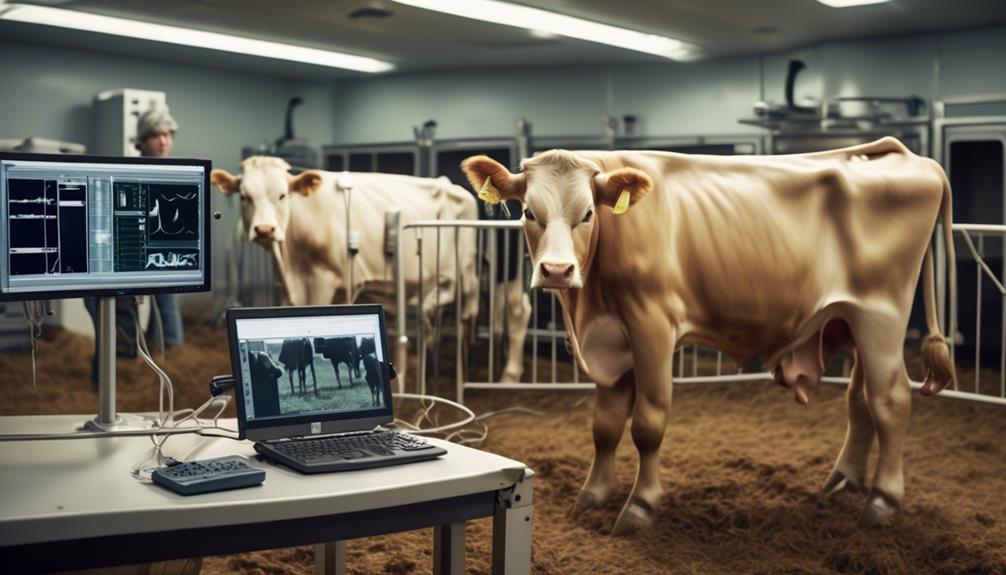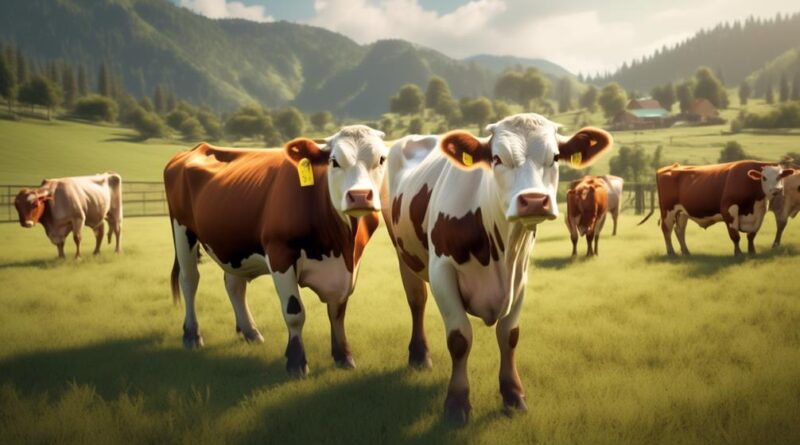13 Tips for Improving Cattle Reproductive Performance
You've probably heard that the reproductive performance of your cattle can significantly impact your bottom line.
But have you ever wondered how to effectively enhance their fertility and breeding success?
With 13 simple yet powerful tips, you can take your cattle reproductive performance to the next level.
From understanding the importance of proper nutrition to implementing advanced reproductive technologies, there are key strategies that can make a substantial difference in your herd's reproductive success.
Proper Nutrition for Fertility
For optimal fertility in cattle, it's crucial to consistently provide a well-balanced diet that meets their nutritional needs. A balanced diet is essential for ensuring that cattle achieve optimal fertility outcomes. When formulating a diet for your cattle, it's important to consider the specific nutritional requirements for reproductive health. This includes providing adequate levels of energy, protein, vitamins, and minerals.
Nutritional supplements can play a key role in supporting reproductive health in cattle. For example, supplements containing essential nutrients such as calcium, phosphorus, and vitamin E can contribute to improved fertility outcomes. Additionally, omega-3 fatty acids have been shown to have a positive impact on reproductive function in cattle. Ensuring that your cattle have access to these nutritional supplements can help support their overall reproductive health.
Incorporating a well-balanced diet along with nutritional supplements can significantly improve fertility outcomes in cattle. It's important to work with a veterinarian or animal nutritionist to develop a diet that meets the specific needs of your herd. Monitoring body condition and overall health indicators can also help determine if the diet is adequately supporting reproductive function. By prioritizing proper nutrition and providing essential supplements, you can contribute to improved fertility and reproductive performance in your cattle.
Breeding Soundness Evaluation
Considering the importance of assessing the reproductive health of your cattle, it's crucial to conduct regular breeding soundness evaluations to ensure optimal breeding outcomes. By doing so, you can identify any potential issues and take corrective measures to maximize your herd's reproductive potential.
Here are a few key points to consider:
- Semen Analysis
- It's essential to routinely perform semen analysis on your breeding bulls to assess their reproductive capabilities. This involves evaluating various parameters such as sperm count, motility, and morphology. By understanding the quality of the semen, you can make informed decisions about which bulls to use for breeding.
- Reproductive Potential
- Breeding soundness evaluations also provide insights into the overall reproductive potential of your cattle. This includes assessing not only the male bulls but also the reproductive health of the female cows. By understanding the reproductive potential of your herd, you can implement targeted strategies to improve breeding outcomes and overall herd fertility.
Conducting regular breeding soundness evaluations can significantly impact the reproductive performance of your cattle. It allows you to detect and address any fertility issues early on, ultimately leading to improved breeding success and healthier offspring. By staying proactive and investing in these evaluations, you can enhance the overall reproductive efficiency of your cattle operation.
Heat Detection and Estrus Synchronization
To improve your cattle's reproductive performance, implementing effective heat detection and estrus synchronization methods is essential.
Improving heat detection accuracy is crucial for successful breeding. Regular observation of behavioral signs such as mounting, chin resting, and mucus discharge can aid in identifying cows in heat. Additionally, using tools like tail paint or chalk can help mark cows that have been mounted, making it easier to track heat cycles. Embracing technological advancements like activity monitoring systems can also enhance heat detection accuracy by alerting you when cows are displaying increased activity associated with estrus.
Synchronizing estrus is another key aspect of optimizing reproductive performance. Hormonal interventions such as prostaglandins and GnRH analogs can be utilized to synchronize estrus in a group of cows, making it easier to plan and manage breeding activities. These interventions can help align the timing of estrus within the herd, streamlining the breeding process and increasing the likelihood of successful conception.
It's important to work closely with a veterinarian to develop a synchronization plan tailored to your herd's specific needs and production goals.
Minimizing Stress for Reproduction
Minimize stress during reproduction by providing a calm and comfortable environment for your cattle, as it can significantly impact their reproductive performance. Reducing handling and effectively managing the environment are crucial in ensuring your cattle are at ease during this critical time. Here are some tips to help you minimize stress and optimize reproductive performance:
- Reducing handling:
- Minimize unnecessary handling: Limiting the amount of handling can help reduce stress in cattle. When handling is necessary, ensure it's done calmly and gently to avoid causing unnecessary anxiety.
- Implement low-stress handling techniques: Utilize methods such as the use of flight zones and point of balance to move cattle in a calm and controlled manner, minimizing stress during handling procedures.
- Environment management:
- Provide comfortable housing: Ensure that your cattle have access to clean, dry, and comfortable housing that protects them from extreme weather conditions. Adequate ventilation and space are also essential for maintaining a stress-free environment.
- Maintain a consistent routine: Cattle thrive on routine, so strive to provide a consistent feeding, watering, and handling schedule. Sudden changes can induce stress, potentially impacting reproductive performance.
Disease Prevention and Control
Ensuring the health and well-being of your cattle through effective disease prevention and control is essential for optimizing their reproductive performance.
Preventing infectious diseases is crucial in maintaining the overall health of your herd. Implementing biosecurity measures, such as controlling the movement of animals in and out of the farm, and regularly vaccinating against common infectious diseases, can significantly reduce the risk of outbreaks. It's important to work with a veterinarian to develop a vaccination program tailored to the specific disease risks in your area.
Controlling reproductive diseases is equally important for cattle reproductive performance. Some common reproductive diseases, such as brucellosis and leptospirosis, can have detrimental effects on fertility and overall herd health. Regular testing and culling of infected animals, along with proper sanitation and hygiene practices, are essential for preventing the spread of these diseases within the herd.
Additionally, maintaining a suitable bull-to-cow ratio and conducting regular breeding soundness evaluations for bulls can help prevent the spread of reproductive diseases and optimize breeding success.
Managing Bull to Cow Ratio
Maintain an optimal bull-to-cow ratio to maximize breeding efficiency and reproductive success in your cattle herd.
Managing the ratio of bulls to cows is crucial for ensuring successful breeding and herd productivity. Here are some essential tips to help you effectively manage the bull to cow ratio:
- Bull Selection
Choose bulls with proven fertility and good breeding soundness. Conduct regular breeding soundness evaluations to ensure that your bulls are in optimal reproductive condition. This will help maximize the breeding potential of each bull in your herd.
- Pasture Management
Utilize pasture rotation to ensure that bulls have access to fresh, high-quality forage throughout the breeding season. Adequate nutrition is essential for maintaining the overall health and reproductive performance of your bulls. Additionally, consider separating bulls from cows during non-breeding periods to prevent excessive wear and tear on the bulls and minimize the risk of injury.
Utilizing Reproductive Technologies

Consider incorporating reproductive technologies to enhance the breeding efficiency and reproductive success of your cattle herd. Utilizing reproductive technologies such as embryo transfer and artificial insemination can significantly improve your herd's reproductive health and genetic selection.
Embryo transfer is a powerful tool that allows you to produce offspring from your best cows more rapidly. It involves collecting embryos from a donor cow and transferring them to recipient cows, enabling you to multiply the genetic potential of your most productive animals. This technology can help you propagate superior genetics throughout your herd, leading to improved overall productivity and profitability.
Artificial insemination (AI) is another valuable reproductive technology that offers benefits such as allowing you to use semen from superior bulls, regardless of their geographical location. This method also facilitates genetic improvement by enabling you to select sires with desirable traits, leading to healthier and more productive calves.
Monitoring Reproductive Performance
To effectively gauge the impact of reproductive technologies on your cattle herd, regularly monitoring reproductive performance is essential for assessing the success of your breeding efforts and genetic selection. By tracking key reproductive metrics and analyzing the data, you can make informed decisions to improve your herd's overall reproductive performance.
- Data Analysis
- Keep detailed records: Maintain comprehensive records of breeding dates, calving intervals, pregnancy rates, and any reproductive issues. This data will be crucial for conducting thorough analysis and identifying trends over time.
- Utilize technology: Consider using software or apps designed for herd management and reproductive tracking. These tools can streamline data collection and analysis, providing valuable insights into your herd's reproductive performance.
- Performance Tracking
- Set performance targets: Establish clear benchmarks for reproductive performance based on industry standards and your herd's specific characteristics. Regularly compare actual performance against these targets to identify areas for improvement.
- Implement regular evaluations: Schedule routine evaluations of reproductive performance to track progress and detect any deviations from expected outcomes. This proactive approach allows for timely interventions and adjustments to breeding strategies.
Frequently Asked Questions
How Can I Improve the Fertility of My Cattle Through Natural Breeding Methods?
To improve your cattle's fertility through natural breeding methods, focus on optimizing the environment, ensuring proper nutrition, and minimizing stress. Additionally, consider using hormonal supplements under veterinary guidance to enhance reproductive performance.
Are There Any Specific Environmental Factors That Can Affect Cattle Reproductive Performance That I Should Be Aware Of?
Environmental factors such as temperature and nutrition can significantly affect cattle reproductive success. It's important to be aware of how these factors can impact your herd's fertility and take steps to mitigate any negative effects.
What Are Some Common Mistakes That Can Negatively Impact Cattle Reproductive Performance?
When it comes to cattle reproductive health, common mistakes like poor genetic selection, inadequate nutrition management, and improper breeding practices can negatively impact performance. It's important to address these factors to improve reproductive outcomes.
Are There Any Alternative Methods or Supplements That Can Be Used to Enhance Cattle Fertility?
Looking to enhance cattle fertility? Supplement options like vitamin E and selenium can improve reproductive performance. Consider alternative breeding methods, such as artificial insemination, to optimize your herd's reproductive success and overall productivity.
How Can I Effectively Track and Analyze the Reproductive Performance of My Cattle Over Time?
To effectively track and analyze your cattle's reproductive performance over time, start by setting up a data collection system. Regularly monitor reproductive health and use this data for analysis to identify trends or potential issues.
Conclusion
Overall, improving cattle reproductive performance requires careful attention to several factors:
- Nutrition: Providing proper nutrition is essential for reproductive success. Ensuring that cattle have access to a balanced diet with adequate levels of energy, protein, minerals, and vitamins can enhance fertility.
- Breeding soundness: Regularly evaluating the breeding soundness of bulls is crucial. Only using bulls that pass a thorough breeding soundness examination can help avoid infertility or low conception rates.
- Heat detection: Proper heat detection is essential for timely breeding. Monitoring cattle closely for signs of heat, such as increased activity, mounting behavior, or mucus discharge, can improve breeding success.
- Stress reduction: Minimizing stress is critical for reproductive performance. Implementing management practices that reduce stress, such as providing proper handling techniques and comfortable housing, can enhance fertility.
- Disease prevention: Preventing and controlling diseases is important for reproductive health. Vaccinating cattle against reproductive diseases, implementing biosecurity measures, and regularly testing for diseases can help maintain herd health.
- Reproductive technology: Utilizing reproductive technologies, such as artificial insemination or embryo transfer, can improve breeding success and genetic progress.
By managing bull to cow ratios and monitoring reproductive performance, you can ensure better fertility and breeding success. With these 13 tips in mind, you can optimize your cattle's reproductive performance and ultimately improve the overall productivity of your herd.
